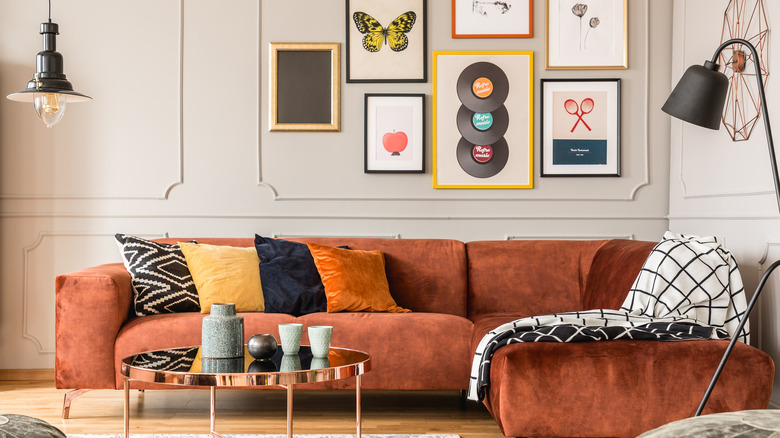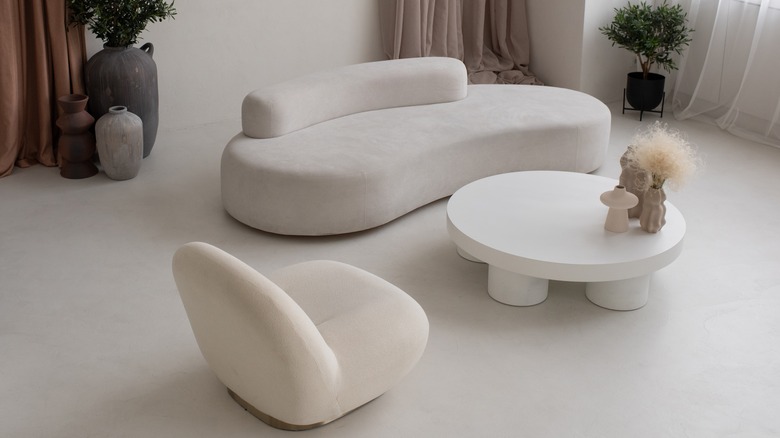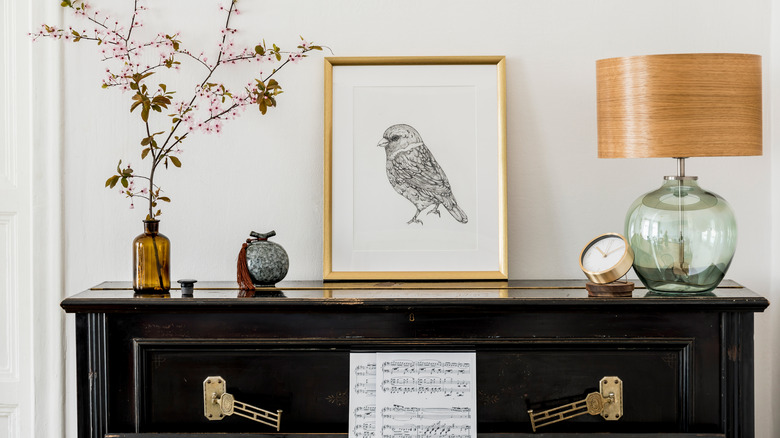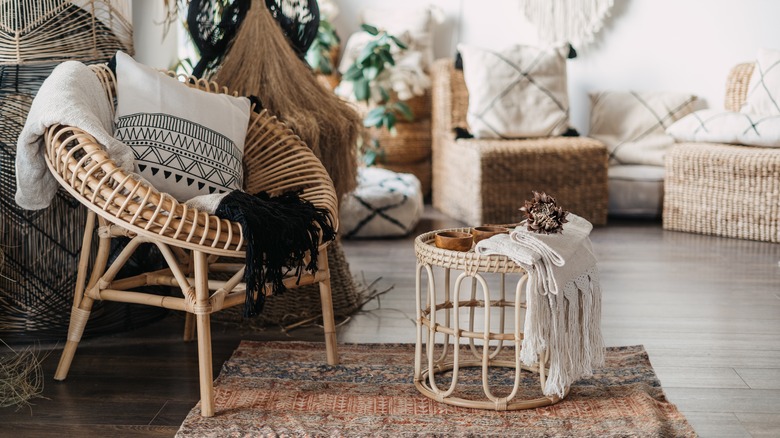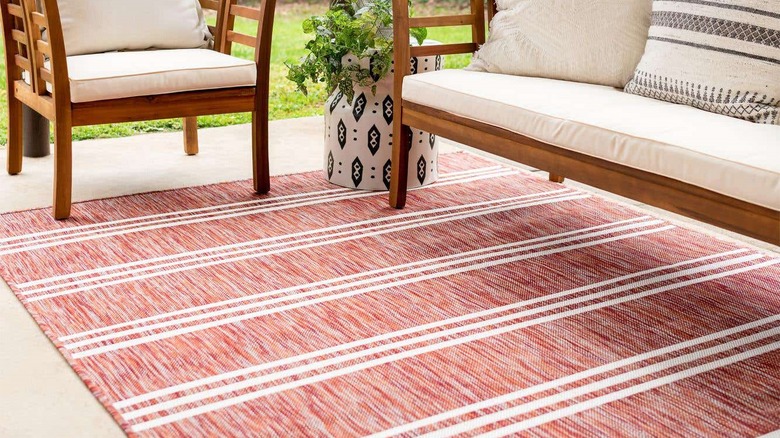These Are Emily Henderson's Best Tips For Designing A Living Room
Emily Henderson knows how to style a room. She won HGTV Design Star, had an HGTV show, "Secrets From a Stylist," and now has a blog where she shares all her tips and tricks to making a home look like a professional had a hand in the design.
The living room can be a tricky space to decorate. It's used by everyone who lives there and by guests who come over to visit. Sometimes it has to blend the styles of two people with different preferences, and it has to be functional for anyone who uses it. You also have to decide if the space should be used formally or informally. Many people use a formal space to entertain guests, while an informal living room mostly entertains the residents, according to Fabric Resource. And how you use yours can be a determining factor in your design.
Entertaining for a dinner party or watching a movie, your living room should be a space you enjoy being in. No matter how you plan to use the space, Emily Henderson has tips for how to style it like a professional.
Mix and match details
For years, sets of furniture were a popular choice. They include sofas, coffee tables, side tables, bookshelves, and television stands that all have the same aesthetic style and finish. Using sets made a room look cohesive, but they've fallen out of favor in recent years. Many designers think that matching furniture makes a room look too perfect, uninteresting, and like it lacks personality. Instead, many suggest mixing and matching pieces to create a more visually interesting look. You can do this with furniture or decor. "No two [lamps] are alike in my living room," Emily Henderson tells HGTV. "I usually choose opposite styles and different heights."
You can source furniture and decor from different places, but how do you make it cohesive? Meg Made suggests finding common ground between each piece, like the style or color palette. And if you know the common ground details, it can make looking for pieces easier. This is always a great tip for combing styles, especially when they're on opposite sides of the spectrum, like masculine and feminine elements. Henderson says, "I keep the major furniture masculine. It's much easier to add feminine accents on masculine pieces than it is to do the reverse."
Shape of furniture matters
When buying your larger pieces, Emily Henderson says that the most important detail to look for is the shape. Most furniture pieces can't have their basic structure changed. So if you like curves over straight lines, look for pieces that have rounded shapes, or vice versa. Henderson suggests buying a piece of furniture with a shape you like, even if you don't like the color or type of fabric or stain of the wood. "Look at the shape of furniture before you look at the fabric ... You can refinish or reupholster anything," she advises to HGTV.
Reupholstering a larger piece of furniture like a sofa is fairly easy and doesn't always require removing the old fabric. It can be as simple as using a staple gun and throw blanket, according to Southern Crush at Home. You can also get sofa or seat covers to change the color or fabric. And if you don't want to do it yourself, there are plenty of services that will reupholster a piece of furniture for you.
Unique pieces add character
You can decorate your room perfectly, but if it doesn't have personality or character, the space can belong to anyone. Instead, you should add pieces that create some visual interest in the room. Decor that speaks to you or reflects your interests will make your home feel like only you could have designed it.
Great places to find these unique items are thrift stores, antique shops, and flea markets. "I wake up at five to be there at six ... My hoarding tendencies are strongest at the flea market where there's one-of-a-kind stuff," Henderson told HGTV. When shopping at these places, Duct Tape and Denim suggests looking for furniture to paint or upcycle, vintage linens, crates, typewriters, and baskets that can be used throughout the home.
Henderson urges us to let statement pieces shine. "Spotting my coffee table was like meeting the love of my life, she said. "I recently saw a brass end table that resembled it, but I decided to leave it behind. Something this great wouldn't look as special if it had a match." Allowing pieces to stand out will give your living room more of the wow factor.
Outside pieces can go inside
Statues, pillows, cushions, and rugs are some of the pieces that have both indoor and outdoor counterparts. But this isn't a hard and fast rule. Sure, materials might be different, but Emily Henderson tells HGTV, "just because something's meant for outside doesn't mean it can't live indoors." Henderson has a dog statue inside her home that's meant to be a yard decoration. It adds a unique element to her design, and her cats seem to love it.
Outdoor rugs are a great durable option for inside your house, according to Oblique New York. They're great in the kitchen, entryway, or anywhere that has a lot of foot traffic. You can also use outdoor furniture to bring more texture into your space. Materials like rattan, jute, and wicker are all popular choices. You can use them inside for more visual interest against sleeker indoor materials like metal, wood, and stone.
Patterns of different sizes
Professional designers have to master the use of color and pattern. Without both of these elements, a room can appear flat and boring. But too many of them can make a room feel too busy and overwhelming. Balancing these elements is what makes a room visually appealing. You might opt for a solid-colored sofa so you can have detail in other areas of the room in the form of printed lamps or decorative objects on shelves.
Emily Henderson mixes a few prints in her living room and has eclectic decor on shelves and tables. "To balance the small prints and knickknacks, I ordered a large-scale rug online for just a few hundred dollars," Henderson tells HGTV. A larger print has more negative space, which helps ground a room. According to Faisal International Rugs, you can tie the rug into the rest of the design by coordinating the primary color in the rug to the furniture, and secondary colors to items like pillows and curtains or to the wall.

